LABOUR WELFARE AND INDUSTRIAL RELATIONS
PAPER – III
Note : This paper contains seventy five (75) objective type questions of two (2) marks each. All questions are compulsory.
1. Assertion (A) : A decline in the role of the state in economic activity need not necessarily lead to decline in its regulatory/supervisory role in labour and industrial relations.
Reason (R) : When private sector becomes engine of growth, the state may need to play a much stronger role in ensuring a balance between the rights of both labour and management.
Codes :
(1) Both (A) and (R) are wrong.
(2) Both (A) and (R) are right and (R) explains (A).
(3) (A) is right and (R) is wrong.
(4) (A) is wrong and (R) is right.
2. A company wants to determine the staffing level required to sustain and improve its sales volume. Out of the following methods which will be used for forecasting the personnel required for the purpose ?
a. Trend analysis
b. Ratio analysis
c. Scatter plot
Codes :
(1) Only b
(2) Only c
(3) Only b and c
(4) a, b and c
3. As per the provisions of the Payment of Gratuity Act, 1972, an employee working in a seasonal establishment shall be deemed to be in continuous service if he has served for not less than :
(1) One hundred twenty days during the period the establishment was in operation.
(2) Seventy-five percent of the number of days on which the establishment was in operation.
(3) One hundred days during the period the establishment was in operation.
(4) Sixty-seven percent of the number of days on which the establishment was in operation.
4. Assertion (A) : The organisational effectiveness should be measured in terms of the entire cycle of the input-process-output system.
Reason (R) : Organisation shall depend on its capacity to adjust with the environment while holding together its internal sub-systems.
Codes :
(1) (A) is right and (R) is wrong.
(2) Both (A) and (R) are right, but, (R) does not explain the (A).
(3) (A) is wrong and in attempting to prove a wrong assertion, the (R) also is wrong.
(4) Both (A) and (R) are right; and (R) explains the (A).
5. Which of the following statements relating to the court of inquiry is not correct ?
(1) The court may consist of one or more persons.
(2) The court is required to submit its report within a period of three months from the commencement of inquiry.
(3) The court of inquiry is an ad-hoc body.
(4) The court of inquiry is primarily a fact-finding machinery.
6. Which of the following statements is/are not correct as per the provisions of the Industrial Disputes Act, 1947 ?
a. A Labour Court cannot adjudicate on disputes relating to discharge and dismissal.
b. An Industrial Tribunal can adjudicate on disputes relating to discharge and dismissal.
c. An Industrial Tribunal can adjudicate on disputes relating to hours of work and rest intervals.
d. A Labour Court cannot adjudicate on disputes relating to leave with wages and holidays.
(1) Only a
(2) a and c
(3) a, b and c
(4) Only d
7. Who corrected the difficulties of Taylor’s differential Piece Rate system of wages ?
(1) Henry Towne
(2) H.L. Gantt
(3) Frank and Lillian Gilberhts
(4) Newmann and Sumner
8. Which of the following statements relating to the trade unions under the Trade Unions Act, 1926 are not true ?
a. Every registered trade union has to submit a half yearly return to the Registrar of Trade Unions.
b. Any person who has attained the age of eighteen can become an office bearer of the trade union.
c. Retired or retrenched employees of an organisation holding an office in a trade union shall not be construed as an outsider.
d. The number of outsiders working as office bearers in registered trade union functioning other than in an unorganised section shall be limited to eight.
(1) a and b
(2) a and d
(3) b and c
(4) a and c
9. Industrial Morale, it is viewed, is related to job satisfaction but both cannot be used interchangeably. Match List – I with List – II :


10. Which of the following is not true relating to the Employees Provident Fund Appellate Tribunal under the Employees’ Provident Fund and Miscellaneous Provisions Act, 1952 ?
(1) A Tribunal shall consist of one person only.
(2) A person so appointed is designated as presiding officer.
(3) A District Judge can be appointed as the Presiding officer.
(4) The term of office of the Presiding Officer shall be for a term of four years from the date he assumes office or attains the age of sixty five, whichever is earlier.
11. The provisions relating to Voluntary Arbitration was included in the Industrial Disputes Act, 1947 through an amendment in the year :
(1) 1948
(2) 1956
(3) 1962
(4) 1971
12. Match the following experiments (List – I) with the pioneers who are associated (List – II) with them :

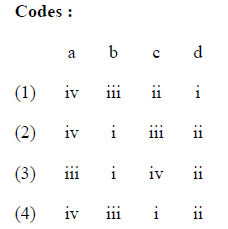
13. Which of the following is not the prescribed hours and periods of work for a child under the Child Labour (Prohibition and Regulation) Act, 1986 ?
a. No child shall work for more than three hours before he has had an interval for rest for half an hour in any day.
b. The period of work should be so arranged that, inclusive of his rest interval, it shall not spread over more than six hours in any day.
c. No child shall be permitted to work between 8 p.m. and 7 a.m.
d. No child shall be required or permitted to work overtime.
(1) a and b
(2) a and c
(3) b and c
(4) c and d
14. Who among the following is the first Indian to become the President of the International Labour Conference ?
(1) Shri Jagjivan Ram
(2) Sir Atul Chatterjee
(3) Dr. Nagendra Singh
(4) Shri Ravindra Verma
15. Which model of H.R.M. propagates that, “if integrated set of HRM practices is applied in a coherent fashion, with a view to achieving the normative goals of high commitment, high quality and task flexibility; then superior individual performance will result; which would lead to superior organisational performance” ?
(1) Harvard model
(2) Warwick model
(3) David Guest model
(4) John M. Storey model
16. If there is any dispute regarding the subsistence allowance payable to a workman, then to which of the following it can be referred for a decision under the Industrial Employment (Standing Orders) Act, 1946 ?
(1) Labour Court constituted under the Industrial Disputes Act, 1947.
(2) Industrial Tribunal constituted under the Industrial Disputes Act, 1947.
(3) Certifying officer appointed under the Industrial Employment (Standing Orders) Act, 1946.
(4) The enquiry officer conducting enquiry against the concerned workman.
17. As per the Provisions of the Minimum Wages Act, 1948, while revising or fixing minimum rate of wages for which of the following categories, different rates of wages may not be fixed ?
a. different scheduled employments
b. adults and adolescents
c. children and apprentices
d. different localities
e. men and women
(1) b and c
(2) e only
(3) c and e
(4) c only
18. Who among the following advocated the Philosophy of “Courts to Codes’ in India ?
(1) G.L. Nanda
(2) Jagjivan Ram
(3) V.V. Giri
(4) J.L. Nehru
19. Assertion (A) : Increase in the number of wage earners led to emergence of two sets of people in the society, the wage earners and wage providers. Karl Marx termed these two classes, opposed to each other, as proletariat and
bourgeoisie and causative factor for the emergence of trade unions.
Reason (R) : After the industrial revolution, concentration of free labourers under one roof took place on a large scale. In order to resist the exploitation of employers, the labourers had no other alternative but to make a common
stand.
Codes :
(1) Both (A) and (R) are wrong.
(2) (A) is right and (R) is wrong.
(3) (A) is wrong but (R) is right.
(4) Both (A) and (R) are correct and (R) explains (A).
20. Arrange the following phases of Hawthorne experiments in the right order :
(a) Mica Splitting Test Room
(b) Bank Wiring Observation Test Room
(c) Experiments on Illumination
(d) Relay Assembly Test Room
(e) Personnel Counselling
(f) Mass Interviewing Programme
Codes :
(1) (c), (d), (a), (f), (b), (e)
(2) (c), (b), (a), (f), (d), (e)
(3) (c), (a), (b), (f), (e), (d)
(4) (c), (d), (f), (b), (a), (e)
21. Which of the following statements about quality is not true ?
(1) Quality is all about meeting or exceeding customer expectation.
(2) Performance, durability, services available and ease of repair are attributes of quality.
(3) W. Edwards Deming and Joseph M. Juran are quality gurus who taught the Japanese on quality issues.
(4) Statistical analyses has no place in Total Quality Management.
22. As per the provisions of the Payment of Gratuity Act, 1972, under which of the conditions an employee shall be entitled for payment of gratuity even if he/she has not rendered five years of continuous service ?
a. On his retirement
b. On his death
c. On his resignation
d. On his disablement due to accident or disease
(1) c and a
(2) a and b
(3) b and d
(4) c and d
23. The book “The Machine that changed the world” which brought the Lean Production and Lean Thinking concept to limelight was authored by :
(1) James P. Womack, Daniel T. Jones and Daniel Roos
(2) Christopher A. Barlett and Sumantra Ghosal
(3) R.M. Kanter, B.A. Stein, T.D. Jick
(4) K.J. Euske and Steven R. Player
24. Which of the following is true relating to payment of subsistence allowance to an employee suspended pending enquiry for the first ninety days under the provisions of the Industrial Employment (Standing Orders) Act, 1946 ?
(1) Sixty percent of the wages the workman was entitled to immediately preceding the date of suspension.
(2) Seventy-five percent of the wages the workman was entitled to immediately preceding the date of suspension.
(3) Fifty percent of the wages the workman was entitled to immediately preceeding the date of suspension.
(4) Thirty-three percent of the wages the workman was entitled to immediately preceeding the date of suspension.
25. What is the current amount of medical bonus paid to a women employee under the Maternity Benefit Act, 1961 ?
(1) Rs.5,000
(2) Rs.3,500
(3) Rs.4,000
(4) Rs.2,500
26. Which set of strategies do not come under the TQM ?
(1) Customer Orientation and Strategic Leadership
(2) Business Process Re-engineering and Lean Thinking
(3) Corporate Governance and Corporate Social Responsibility
(4) Learning, Experimentation and Continuous Improvement
27. Arrange the following developments in Industrial relations philosophy in the order in which it occurred from the latest to the earliest.
(a) Socialistic orientation
(b) Kochan, Katz and McKersie’s strategic choice orientation
(c) Marxian orientation
(d) Capitalistic orientation
(e) Dunlop’s system orientation
(1) (d), (a), (e), (c), (b)
(2) (b), (e), (a), (c), (d)
(3) (d), (c), (a), (e), (b)
(4) (b), (a), (c), (e), (d)
28. As per the provisions of the Industrial Employment (Standing Orders) Act, 1946, for which of the following organisations the Central Government is not the appropriate Government ?
(1) Railways
(2) Major Ports
(3) Banks
(4) Mine and Oilfields
29. Examine the formula of dynamics of change given below; where ‘C’ stands for change; ‘A’ represents the level of dissatisfaction with the Status Quo; ‘B’ indicates the clear desired goal; D refers to the practical first step; and ‘X’ stands for cost of change.
Formula C = (ABD) > X
Considering the formula, if A and B have high values but D is zero, what would be the result ?
(1) Change will occur slowly.
(2) Change will not occur as the product of ABD would be zero.
(3) Change will occur as the cost of change will be less.
(4) Change will not occur as the cost of change will be more.
30. The Second Industrial Truce Resolution was passed in the year _____.
(1) 1948
(2) 1956
(3) 1962
(4) 1991
31. Which of the following is not a part of Peter M. Senge’s Five Disciplines ?
(1) Systems Thinking
(2) Personal Mastery
(3) Trust
(4) Shared Vision
32. Match the following doctrines (List – I) with the defences used by the employer to reject the claims of compensation in case of employment injury (List – II) :
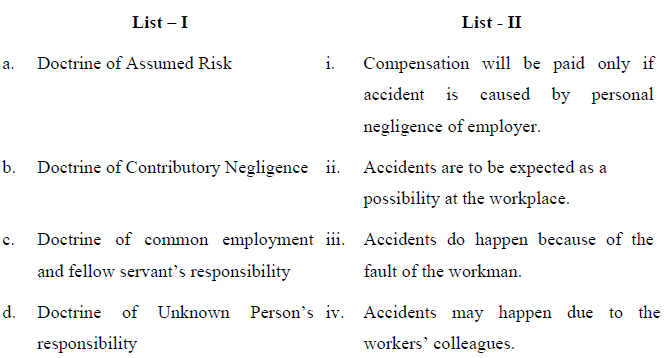
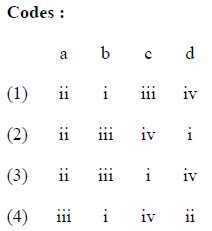
33. The Constitution of India deals with distribution of legislative powers between Central and State legislatures. The provision is contained under which Article of the Constitution of India ?
(1) Article 244
(2) Article 245
(3) Article 246
(4) Article 247
34. Each labour legislation, which has been enacted, is based on certain underlying principles. Match the legislations with underlying principle :
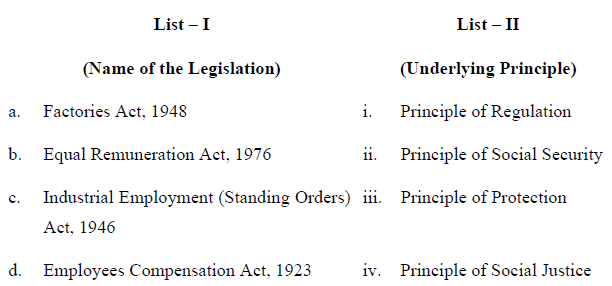

35. The first craft union was organized by shoemakers in Philadelphia, USA in the year :
(1) 1786
(2) 1788
(3) 1792
(4) 1806
36. Read the following statements :
Unions demand high wages to counter inflationary pressures on the economic conditions of the working class. Higher wages enhance the purchasing power of the workers, thereby raising inflation.
Which of the following inferences are wrong ?
a. Unions have the sole purpose of improving the economic conditions of workers.
b. Enhanced wages increase the purchasing power of workers.
c. Inflation and purchasing power are negatively correlated.
d. Inflation drives unions to go for demanding higher wages.
(1) a and c
(2) b and c
(3) c and d
(4) only c
37. Assertion (A) : Trade Union has the potential to increase inflation.
Reason (R) : Unions persistently demand upward revision of wages and thereby enhance purchasing power of labour.
Codes :
(1) Both (A) and (R) are right; (R) does not explain (A).
(2) Both (A) and (R) are wrong.
(3) (A) is right; and (R) explains (A).
(4) (A) is wrong and (R) is right.
38. As per the force field analysis, change will take place when
(1) Driving force equals the restraining force
(2) Driving force and the restraining force correlate with one another
(3) Driving force is stronger than restraining force
(4) Restraining force is stronger than driving force
39. Match the authors (List – I) with the seminal works they have published (List – II) :
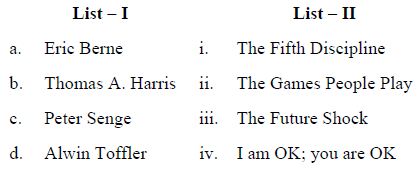
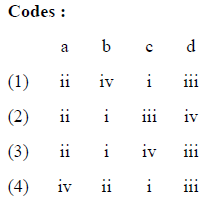
40. The I.L.O. set forth few fundamental principles at the time of its inception. These principles are embodied in the form of Charter of Freedom of Labour. These principles were again reaffirmed at its General Conference along with other Charter and are popularly known as Philadelphia Charter. This was done in the year :
(1) 1926
(2) 1942
(3) 1944
(4) 1946
41. Which of the following statements about Industrial Relations Systems in Multinational Corporations is true ?
a. North American MNCs attempt to make their foreign subsidiaries union free.
b. Following their tradition, Japanese MNCs set up enterprise unions at foreign subsidiaries.
c. West European MNCs believe in organised independent trade unions.
d. In general MNCs show gradations in the degree of policy of centralisation/decentralisation in the areas of industrial relations.
(1) a, b and c
(2) b, c and d
(3) a and b only
(4) a, b, c and d
42. Examine the following statements relating to Induction and identify those which are either true or false :
a. Induction today is renamed as Employee Orientation Programme.
b. It is also known by the term ‘On boarding’.
c. It is for the purpose of socializing the new employees.
d. Informal induction is better than formal induction.
(1) a, b are true; c, d are false.
(2) b, c are true; a, d are false.
(3) a, b, c are true; d is false
(4) a, b, d are true, c is false
43. Assertion (A) : All labour legislations are social in character.
Reason (R) : Social legislation embraces action by government authority to eliminate objectionable elements of the socio-economic system and provide elements for which the system does not make provision.
Codes :
(1) (A) is wrong and (R) is correct.
(2) Both (A) and (R) are correct and (R) explains (A).
(3) Both (A) and (R) are wrong.
(4) (A) is correct but (R) is wrong.
44. Which of the following theories of motivation classifies persons as ‘Intrinsically motivated’ and ‘extrinsically motivated’ ?
(1) Reinforcement Theory
(2) Alderfer’s ERG Theory
(3) Adam’s Equity Theory
(4) Cognitive Evaluation Theory
45. What is common to Sir William Garrow’s Judgement (1816) in Great Britain; the Philadelphia Cordwainers’ case (1806) in U.S.A.; and Madras Labour Union case (1921) in India ?
(1) Declared the combination of workers legal.
(2) Declared the combination of workers illegal.
(3) Declared the combination of workers quasi-legal.
(4) Declared the combination of workers ethical but not legal.
46. Which of the following is not true relating to prohibition of strikes in public utility services under the Industrial Disputes Act, 1947 ?
(1) Without giving to the employer notice of strike within six weeks before striking.
(2) Before the expiry of the date specified in the notice of strike.
(3) Within fourteen days of giving a notice of strike.
(4) During the pendency of any conciliation proceedings and ten days after conclusion of such proceedings.
47. Match the following :
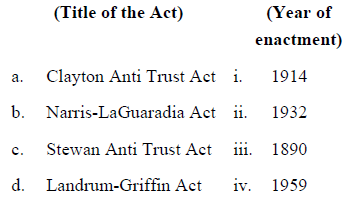
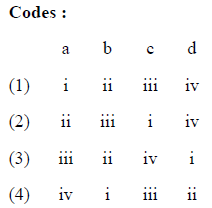
48. The method by which internal wage differentials are determined is called
(1) Wage survey
(2) Wage bargaining
(3) Job evaluation
(4) Wage regulation
49. When an undertaking is closed down on account of unavoidable circumstances beyond the control of the employer, the compensation to be paid to the workmen under the Industrial Disputes Act, 1947 shall not exceed his
(1) Average pay for three months
(2) Average pay for four months
(3) Average pay for six months
(4) Average pay for five months
50. Benchmarking involves employees learning and adopting so called “best practices” by comparing their HRM practices with those of other (more successful) organisations.
Identify the correct sequential steps of Benchmarking.
a. Indentify HR practices for benchmarking.
b. Identify benchmarking partners.
c. Constitute a core or a project team to handle the benchmarking process.
d. Develop action plans to improve HR strategy and practices.
e. Collect data from each of the benchmarking partners.
f. Analyse and interpret the data.
g. Prepare a comprehensive report based on the data analysis and interpretation.
Codes :
(1) a, c, e, b, g, d, f
(2) d, e, f, c, a, b, g
(3) a, c, b, e, f, g, d
(4) d, c, a, b, e, f, g
51. In UK, the voluntary arbitration procedure was first introduced under the :
(1) Conciliation Act of 1896
(2) Industrial Courts Act of 1919
(3) Employment Protection Act of 1975
(4) Trade Union and Labour Relations Act of 1974
52. Which of the following is correct relating to payment towards sickness benefit under the Employees’ State Insurance Act, 1948 to an eligible employee ?
(1) Fifty percent of wages for a maximum of ninety five days in a year.
(2) Seventy percent of wages for a maximum of one hundred days in a year.
(3) Seventy percent of wages for a maximum of ninety-one days in a year.
(4) Sixty percent of wages for a maximum of seventy eight days in a year.
53. Examine the following statements on the line and staff and identify the ones which are true.
a. Line and staff concept originated from Military.
b. Line decides and staff assists.
c. Personnel role is performed both by line and staff.
d. The Personnel Department’s role is a staff function.
(1) b and d are true.
(2) a, b and d are true.
(3) b, c and d are true.
(4) a, b, c and d are true.
54. The American Federation of Labour and the Congress of Industrial Organisations merged in the year :
(1) 1936
(2) 1948
(3) 1955
(4) 1958
55. The lists of injuries deemed to result in Permanent Total Disablement and Permanent Partial Disablement are provided in which Schedule of the Employees’ Compensation Act, 1923 ?
(1) Schedule – I
(2) Schedule – II
(3) Schedule – III
(4) Schedule – IV
56. Assertion (A) : One of the important duties of the modern HR manager is to get things done through people. He has to bring employees into contact with the organisation in such a way that the objectives of both the groups are
achieved.
Reason (R) : The cross-cultural, cross-border mingling has resulted in the creation of a new class of people-global citizens with global attitudes, tastes, and networks. Since it unleashes multiple variables, the borderless world
precludes immense complexity-complexity in the environment, in interorganisational relationships, in modes of conducting business and in socio-cultural diversity.
Codes :
(1) (A) is true, (R) is false.
(2) (A) and (R) both are true, (R) explains (A).
(3) (A) and (R) both are false.
(4) (A) and (R) both are true, (R) does not explain (A).
57. Match the following :


58. Which of the following is true relating to the appointment of the Chairman of the State Advisory Board constituted under the Contract Labour (Regulation and Abolition) Act, 1970 ?
(1) Labour Commissioner of the State is the ex-officio Chairman
(2) Labour Minister of the State is the ex-officio Chairman
(3) Chairman is appointed by the State Government
(4) Chairman is appointed by the State Government in consultation with the Central Government
59. Which of the following statements about the awareness positions described below in respect of Johari Window Model of Interpersonal process are correct.
a. Shared and mutually held, public information, feelings, motives etc.
b. Hidden information, motives, feelings etc. known only to the self.
c. Unsuspected information, feelings, reactions, etc. known only to other parties.
d. Undiscovered potentials and creative reservoir known neither to the self nor to others.
Codes :
(1) a, b, c, d refers to Blindspot, Dark, Closed and Arena respectively.
(2) a, b, c, d refers to Arena, Closed, Blindspot and Dark respectively.
(3) a, b, c, d refers to Arena, Blindspot, Dark and Closed respectively.
(4) a, b, c, d refers to Blindspot, Arena, Dark and Closed respectively.
60. The nature of employment relations in general in India is
(1) Deregulated Competitive
(2) Constrained Competitive
(3) Regulated Protective
(4) Protective Competitive
61. The Fish Bone analysis is associated with which of the following ?
(1) Quality circles
(2) Conflict Management
(3) Performance Appraisal
(4) Incentive Plan
62. Which of the following are not included under ‘Wages’ as per the Employees’ Compensation Act, 1923 ?
a. Travelling allowance
b. Any privilege or benefit which is capable of being estimated in money
c. Value of any travelling concession
d. Contribution paid by the employer of an employee towards any pension or provident fund
Codes :
(1) a, b and c
(2) b, c and d
(3) a, c and d
(4) a, b and d
63. Weisbord M.R. (1976) proposed an Organisational Diagnosis Model, which is one of the most popular, straight forward and easy to use system models.
This model is known as
(1) Out of Box model
(2) In Box model
(3) Eight Box model
(4) Six Box model
64. Under the provisions of the Factories Act, 1948 the total number of hours of overtime in a quarter of a year shall not exceed :
(1) Fifty hours
(2) Fifty-six hours
(3) Sixty hours
(4) Forty-eight hours
65. Who suggested for setting up of Joint Workers’ Councils ?
(1) Bombay Committee, 1920
(2) Bengal Committee, 1920
(3) Royal Commission on Labour, 1931
(4) Government of India Act, 1935
66. Monotony refers to the undesirable effects of repetitive work. The monotony curve distinctly justifies this statement. Which among the following statements is not correct about monotony curve ?
a. The production will fall only in the last hours of production.
b. Production will be constant in the initial hours.
c. Fluctuations are noticed after long hours of work.
d. Fluctuations occur from beginning under impact of monotony.
e. Production falls significantly during middle hours of work.
Codes :
(1) a and b
(2) d and e
(3) b and c
(4) c and d
67. Under the Provisions of the Contract Labour (Regulation and Abolition) Act, 1970 if any difficulty arises in giving effect to the Provisions of the Act, then which of the following is competent to remove the difficulty ?
(1) State Government
(2) Central Government
(3) Labour Courts established under the Industrial Disputes Act, 1947
(4) Central Advisory Board
68. Who among the following is not a dependant under the Employees’ Compensation Act, 1923 ?
(1) A widower
(2) A minor illegitimate son
(3) A daughter-in-law
(4) A minor widowed sister
69. Read the following statement and indicate where the same was incorporated :
“In a socialist democracy, labour is a partner in the common task of development and should participate in it with enthusiasm. There should be joint consultation, workers and technicians should, wherever possible, be associated progressively in management.
Enterprises in the public sector have to set an example in this respect.”
(1) Industrial Policy Resolution, 1948
(2) Industrial Policy Resolution, 1956
(3) National Commission on Labour Report, 1969
(4) Industrial Relations Bill, 1978
70. The latest amendment that was made to the Industrial Disputes Act, 1947 was in the year :
(1) 2008
(2) 2009
(3) 2010
(4) 2015
71. Any disagreement or dispute between an employer and an apprentice arising out of the contract of Apprenticeship shall be referred to which of the following under the Apprenticeship Act, 1961 ?
(1) Apprenticeship Advisor
(2) Apprenticeship Board
(3) Director, Technical Education
(4) Regional Board
72. Adler and Ghadar’s Model (1990) is based on Vernon’s Life Cycle Theory, Vernon distinguished three phases in the international product life cycle.
Match the phases (List-A) with their descriptions given in List – B :
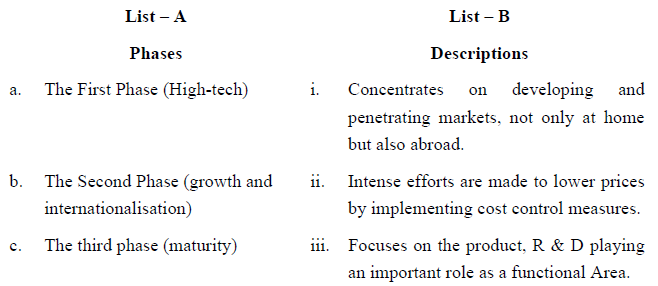
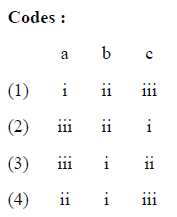
73. The foundation stone for union-management cooperation is said to have been laid in India in :
(1) Oil Industry in 1977
(2) Textile Industry in 1982
(3) Jute Industry in 1957
(4) TISCO in 1938
74. Which of the following is not true regarding the eligibility conditions for claiming the “Unemployment Allowance” under the Employees State Insurance Scheme ?
(1) Should have been an insured person under the ESI Act, 1948 on the date of loss of employment.
(2) Should have contributed to the scheme for at least four years prior to the loss of employment.
(3) Should have become unemployed involuntarily because of permanent invalidity due to non-employment injury.
(4) Should have become unemployed involuntarily due to closure of a factory or establishment.
75. Perlmutter (1969) has proposed and distinguished three attitudes of Top management with respect to internationalisation, which influence the organisational structure, lines of communication and information, and approach to HRM activities etc.
Match the attitude (List-A) with their descriptions given in (List-B) :
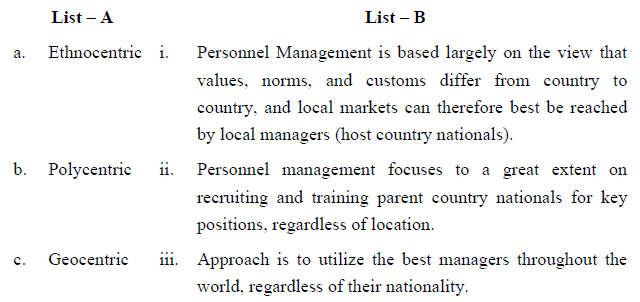

Latest Govt Job & Exam Updates: